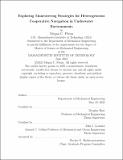| dc.contributor.advisor | Hart, Douglas | |
| dc.contributor.advisor | Leonard, John J. | |
| dc.contributor.author | Flynn, Megan C. | |
| dc.date.accessioned | 2023-08-23T16:19:02Z | |
| dc.date.available | 2023-08-23T16:19:02Z | |
| dc.date.issued | 2023-06 | |
| dc.date.submitted | 2023-07-19T18:45:11.470Z | |
| dc.identifier.uri | https://hdl.handle.net/1721.1/151918 | |
| dc.description.abstract | Due to the challenges of the underwater environment and limited communication methods, undersea navigation is difficult. Autonomous underwater vehicles (AUVs) experience unbounded localization errors when operating below the surface. Range measurements between vehicles can be utilized to improve localization estimates. We define a two-agent team composed of a leader and a follower, in which the former has better navigational capabilities than the latter. The follower attempts to navigate to a destination while the leader aids in the follower’s localization by providing range measurements from varied locations. Planning the relative motion between agents is vital to ensuring that meaningful range measurements are provided to support an effective estimation of the follower’s pose.
This work explores five different maneuvering strategies based on geometric and observability principles. After designing the strategies, we tested their impact on the localization quality of the team through extensive simulation results. To investigate the resilience of the strategies to environmental conditions, we altered the simulated ocean currents. For additional study we allowed the leader to operate at a higher speed to explore the relationship between energy use and estimation performance.
Ultimately, the best maneuvering strategy was found to be the circling strategy due to its superior performance; however, the circling strategy used the most energy, especially with larger radii. Mission priorities may affect the selection of a maneuvering strategy; the zigzag and covariance squish strategies are still viable options as they do not suffer great performance loss when compared to the circling strategy. | |
| dc.publisher | Massachusetts Institute of Technology | |
| dc.rights | In Copyright - Educational Use Permitted | |
| dc.rights | Copyright retained by author(s) | |
| dc.rights.uri | https://rightsstatements.org/page/InC-EDU/1.0/ | |
| dc.title | Exploring Maneuvering Strategies for Heterogeneous Cooperative Navigation in Underwater Environments | |
| dc.type | Thesis | |
| dc.description.degree | S.M. | |
| dc.contributor.department | Massachusetts Institute of Technology. Department of Mechanical Engineering | |
| dc.identifier.orcid | https://orcid.org/0009-0000-1540-1892 | |
| mit.thesis.degree | Master | |
| thesis.degree.name | Master of Science in Mechanical Engineering | |
